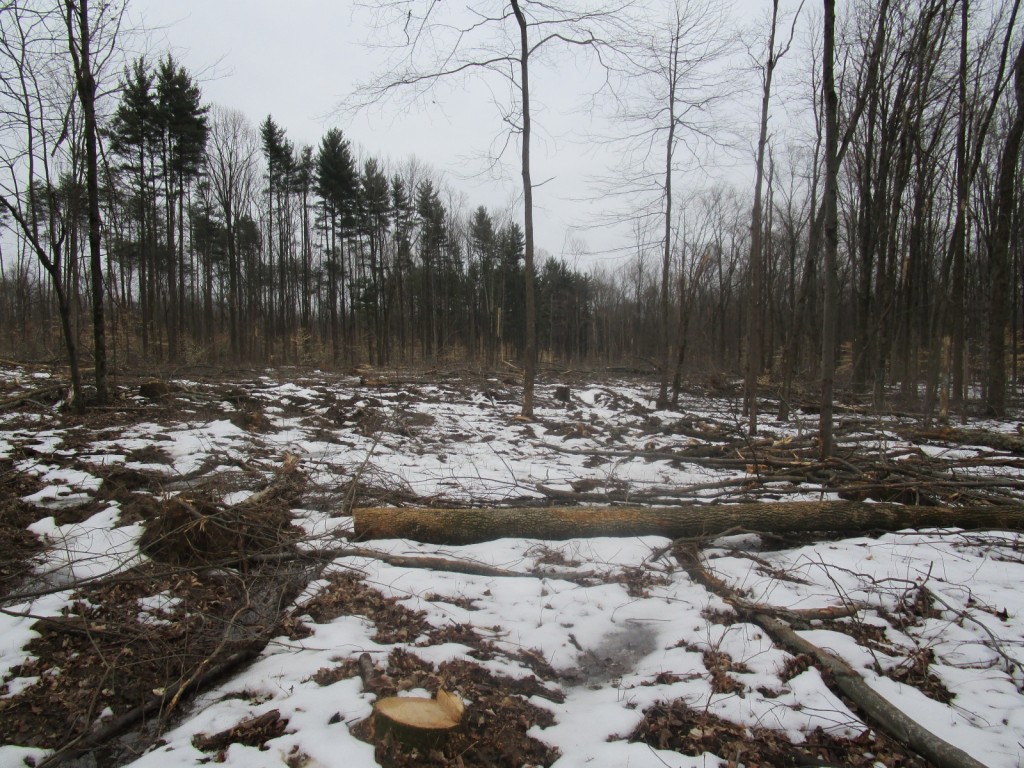By Charlie Cole, IFA Board Member
This month, the Indiana Division of Forestry released plans to log and sell timber from four tracts in Yellowwood State Forest. Last February, I led members of the Brown County League of Women Voters and friends to see a Yellowwood State Forest clear-cut adjacent to Dubois Ridge Road. We saw visible evidence of different management strategies and their effects on the forest succession. And it’s not a pretty picture.
A Quick Primer on Natural Forest Growth
The process of natural forest succession occurs in every forested environment world-wide, even though the representatives of each stage of succession have a identity specific to their unique location. There are three basic stages of forest succession: the (1) pioneer stage; (2) intermediate stage; and (3) climax forest. The pioneer trees that first appear in Indiana forest clearings are usually transported by birds or wind. In Indiana, sycamore, poplar, and tulip seeds for example, are transported by wind, while red cedar, sumac, black locust, redbud, dogwood and sassafras are typical pioneer trees transported by birds and mammals carrying and dropping edible seeds and berries. Most pioneer trees grow more quickly in marginal conditions when competing for sunlight than do trees representing later stages of successional growth. They prepare the area for the next, intermediate stage by enriching and creating soil conditions that encourage further succession to occur.
This second stage of succession is dominated by slower-growing hardwoods such as black cherry, oaks, hickories, and ash. These trees eventually overtake the pioneer trees in height and girth, and they eventually outcompete them for available light and resources. They, in turn, condition the forest soil for the last stage, the climax forest, which consists of beech and sugar maple.
These last two species grow slowly beneath the canopy of the intermediate stage, but eventually they become large enough to dominate the competition for available light and resources. They will eventually overtake the medium stage as soil conditions improve. Only small beeches and maples can thrive in the ensuing dark forest floor conditions. The climax stage remains in dominance until natural disturbance from wind, water, or fire creates a new, small, sunlit opening in the forest where succession will reoccur.
Today’s state foresters are not allowing this natural cycle to occur, and their interruptive and fruitless efforts to grow currently popular intermediate hardwoods short-circuits this forest succession in the second stage.
What Dictates the Timber Harvest Agenda?
Commercial timber market value of the hardwoods dictates the harvest agenda for current state foresters. Recent logging efforts in Yellowwood have focused on harvesting the walnuts and oaks of the intermediate stage, and the forest is now not allowed to cycle through the other two successional stages naturally. A good analogy would be a farmer growing corn on the same plot for ten consecutive years without alternating in some crops of hay and soybeans, which enrich the soil and therefore allow for more corn to be grown (in rotation with the two other crops). Forestry officials are unable to successfully introduce commercially popular species back into the succession using their current strategies. Soil compaction in logged areas also inhibits re-growth. Current deer predation of small oak seedlings is near 100% in Yellowwood.
The size and scale of naturally-occurring forest disturbance is dwarfed by the amount of permanent, man-made damage done in recent large, erosion-prone Yellowwood clear cuts. The Indiana Forest Alliance estimates that at the current rate of extraction, our state forests will be gutted within the next 12 years.
Best management practices (BMPs) previously used to minimize soil erosion have recently been ignored, and no new invasive species BMPs have been initiated by present-day DNR brass to stop the spread of invasives from contaminated private logging and DNR soil-moving equipment. State Forest officials also are not alerting Hoosiers in a timely manner to the presence and severity of new invasive species (sudden oak death, thousand canker walnut disease, Asian Boring Beetles, etc.) in Indiana.
Be a Part of the Solution
The Indiana Forest Alliance is collaborating with scientists to conduct “ecoblitzes” (wildlife study expeditions) to inventory the rich diversity of life existing in currently-undestroyed state forest properties. State Senator Brent Steele and State Representative Eric Koch sponsored a bi-partisan bill to protect 10% of State Forest acreage from the current, one-size-fits-all policy of forest destruction.
You can sign a public petition (hard copy, or digital) to Governor Pence to demand that he reconsider his forest policies.
Charlie Cole has lived in the heart of Yellowwood for 32 years and serves on the IFA board of directors. He is an IU graduate, certified outdoor educator and former state park naturalist. He is a charter member of Friends of Yellowwood and the Yellowwood Watershed Group.

